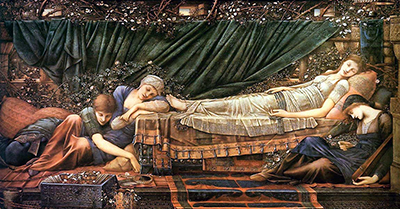Sir Edward Coley Burne-Jones was absolutely fascinated by the legend of the sleeping beauty. This fairytale has been a favourite with generations of children. It's loved and hated in equal measure, as many modern women detest the idea that females are depicted as helpless, waiting for a man’s kiss to awaken them to life.
Like many stories from the Brothers Grimm collection, it has a dark side. Sir Edward Coley Burne-Jones, the 19th-century aristocrat who was also a talented and prolific artist, based a whole collection on what was named ‘The Legend of the Briar Rose’. While Sleeping Beauty refers to a collection by Sir Edward Coley Burne-Jones, there is one particular work, ‘La Belle au Bois Dormant’. That’s the French title of the story. 'La Belle au Bois Dormant' differs from the other works in the collection. While most of the works in the Legend of the Briar Rose collection are rich, detailed paintings,’ La Belle au Bois Dormant’ is a totally different artistic medium. The work entitled ‘La Belle au Bois Dormant’ has the appearance of a sketch.
It's actually a ‘collotype’ on brown light brown wove paper. The figure of a young woman asleep can be clearly seen. However, a collotype is not a sketch. It's actually a primitive type of photography. It seems that Sir Edward Coley Burne-Jones used a real-life model as the inspiration for his painting collection. Or is this the photograph of a painting? Probably not. This depiction, which was created in 1894, is a fascinating insight into a legendary collection of paintings.
The 19th-century artist, Sir Edward Coley Burne-Jones was born in 1833 and died in 1898. He was considered a star of the aesthetic movement at the time. His paintings, both oils and watercolours, were full of drama and romance. Sir Edward was a baronet and was the perfect model of a nobleman indulging in his passion for art. He was an avid crafter as well as an artist. He designed ceramic tiles and jewellery, not to mention tapestries and mosaics. He is also known for his work in stained glass windows. His work still adorns some historic churches today.




